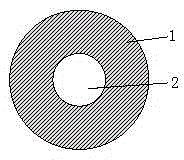Sheath-core type low-melting-point copolyamide composite fiber and preparation method thereof
A technology of copolyamide and composite fiber, which is applied in the direction of conjugated synthetic polymer artificial filament, fiber treatment, filament/thread forming, etc., which can solve the problem of hard spots, melting and shrinkage on the cloth surface, affecting the style and feel of the fabric, etc. problem, to achieve the effect of improving tensile strength and tear resistance, good molding, and avoiding shrinkage problems
- Summary
- Abstract
- Description
- Claims
- Application Information
AI Technical Summary
Problems solved by technology
Method used
Image
Examples
Embodiment 1
[0036] (1) Place copolyamide slices with a melting point of 105°C to 120°C in a vacuum drum for drying. The drying temperature is 60°C, the vacuum degree is -0.2MPa, dried for 14 hours, and the moisture content of the slices reaches 189ppm.
[0037] (2) Feed the dried copolyamide chips and polypropylene chips into the screw extruder respectively for heating and plasticization. The screw extrusion plasticization temperature of the copolyamide chips is 168°C, 172°C, 175°C, 175°C, 175°C , The plasticizing temperature of polypropylene chip screw extrusion is 220°C, 221°C, 222°C, 222°C, 222°C.
[0038] (3) Copolyamide slices and polypropylene slices are respectively melted and plasticized by the screw, and then measured by two metering pumps according to the weight ratio of 80:20, and the melts are extruded into the same composite component to form a skin-core section and then sprayed Holes are ejected to obtain primary silk.
[0039] (4) The as-spun silk is cooled, oiled, drawn a...
Embodiment 2
[0042] Only the weight ratio of copolyamide chips and polypropylene chips was changed to 70:30, and the same spinning process as in Example 1 was adopted to obtain sheath-core low-melting point copolyamide composite fibers.
[0043] The obtained composite fiber has a linear density of 149.8D, a breaking strength of 3.25cN / dtex, and a breaking elongation of 53%. The composite fiber is applied to the post-weaving process, and the fabric can be melted and bonded at a heat treatment temperature of 120°C, and its tear resistance is good, which can meet the use requirements.
Embodiment 3
[0045] (1) Place copolyamide slices with a melting point of 90°C to 102°C in a vacuum drum for drying at a drying temperature of 56°C and a vacuum of -0.13MPa for 13 hours, and the moisture content of the slices reaches 180ppm.
[0046](2) Feed the dried copolyamide chips and high-density polyethylene chips into the screw extruder respectively for heating and plasticization. 134°C, the plasticizing temperature of high-density polyethylene chip screw extrusion is 168°C, 170°C, 170°C, 170°C, 170°C.
[0047] (3) Copolyamide slices and high-density polyethylene slices are respectively melted and plasticized by the screw, and then measured by two metering pumps according to the weight ratio of 85:15. The silk holes are sprayed out to obtain primary silk.
[0048] (4) The as-spun silk is cooled, oiled, drawn and shaped, and wound into a tube to obtain a composite fiber. The drawing temperature is 53°C, the setting temperature is 67°C, the draw ratio is 2.0, and the winding speed is...
PUM
| Property | Measurement | Unit |
|---|---|---|
| Linear density | aaaaa | aaaaa |
| Melting point | aaaaa | aaaaa |
| Melting point | aaaaa | aaaaa |
Abstract
Description
Claims
Application Information
 Login to View More
Login to View More - R&D
- Intellectual Property
- Life Sciences
- Materials
- Tech Scout
- Unparalleled Data Quality
- Higher Quality Content
- 60% Fewer Hallucinations
Browse by: Latest US Patents, China's latest patents, Technical Efficacy Thesaurus, Application Domain, Technology Topic, Popular Technical Reports.
© 2025 PatSnap. All rights reserved.Legal|Privacy policy|Modern Slavery Act Transparency Statement|Sitemap|About US| Contact US: help@patsnap.com

